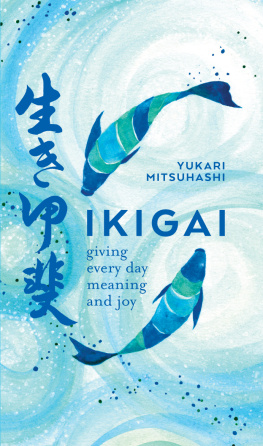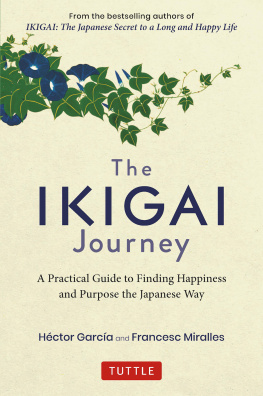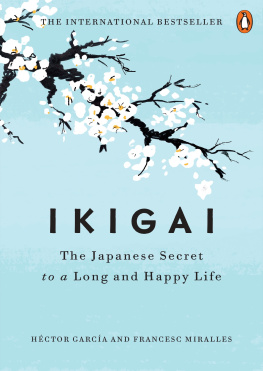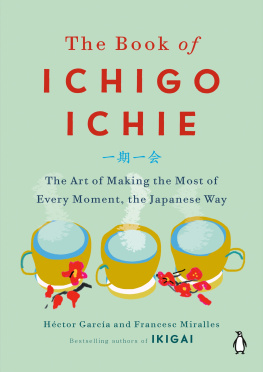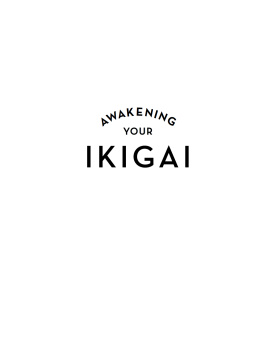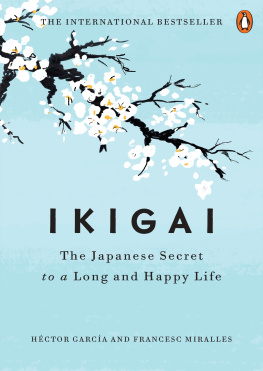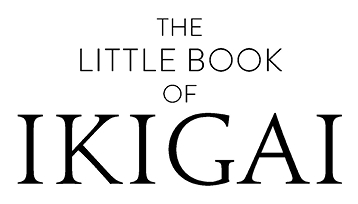The Little Book of Ikigai
Title
Copyright
This ebook edition first published in 2017 by
Quercus Editions Ltd
Carmelite House
50 Victoria Embankment
London EC4Y 0DZ
An Hachette UK company
Copyright Ken Mogi 2017
The moral right of Ken Mogi to be
identified as the author of this work has been
asserted in accordance with the Copyright,
Designs and Patents Act, 1988.
All rights reserved. No part of this publication
may be reproduced or transmitted in any form
or by any means, electronic or mechanical,
including photocopy, recording, or any
information storage and retrieval system,
without permission in writing from the publisher.
A CIP catalogue record for this book is available
from the British Library
EBOOK ISBN 978 1 78648 904 3
Every effort has been made to contact copyright holders.
However, the publishers will be glad to rectify in future editions
any inadvertent omissions brought to their attention.
Quercus Editions Ltd hereby exclude all liability to the extent permitted
by law for any errors or omissions in this book and for any loss, damage or expense
(whether direct or indirect) suffered by a third party relying on
any information contained in this book.
Illustrations by Amber Anderson
Ebook by CC Book Production
Cover design 2017 Ghost Design
www.quercusbooks.co.uk
Contents
Contents
NOTE TO THE READER
The Five Pillars of ikigai
NOTE TO THE READER: The Five Pillars of ikigai
Throughout this book, I refer to the Five Pillars of ikigai . They are:
Pillar 1: Starting small
Pillar 2: Releasing yourself
Pillar 3: Harmony and sustainability
Pillar 4: The joy of little things
Pillar 5: Being in the here and now
These pillars come up frequently, because each one provides the supportive framework the very foundations that allows ikigai to flourish. They are not mutually exclusive or exhaustive, nor do they have a particular order or hierarchy. But they are vital to our understanding of ikigai , and will provide guidance as you digest what you read in the forthcoming pages and reflect on your own life. Each time they will come back to you with a renewed and deepened sense of significance.
I hope you enjoy this journey of exploration.
CHAPTER 1
What is ikigai ?
CHAPTER 1: What is ikigai ?
When President Barack Obama made his official visit to Japan in the spring of 2014, it befell Japanese government officials to choose a venue for the welcome dinner to be hosted by the Prime Minister of Japan. The occasion was to be a private affair, preceding the state visit which was due to start officially the following day, and which included a ceremonial dinner at the Imperial Palace, with the Emperor and Empress presiding.
Imagine how much consideration went into the choice of restaurant. When it was finally announced that the venue was to be Sukiyabashi Jiro, arguably one of the worlds most famous and respected sushi restaurants, the decision was met with universal approval. Indeed, you could tell how much President Obama himself enjoyed the experience of dining there from the smile on his face when he stepped out. Reportedly, Obama said it was the best sushi he had ever eaten. That was a huge compliment coming from someone who grew up in Hawaii, with exposure to a strong Japanese influence including sushi, and who, presumably, had had many previous experiences of haute cuisine .
Sukiyabashi Jiro is proudly headed by Jiro Ono, who is, as I write this, the worlds oldest living three-Michelin-star chef, at the age of ninety-one. Sukiyabashi Jiro was already famous among Japanese connoisseurs before the first Michelin Guide for Tokyo in 2012, but that publication definitely put the restaurant on the world gourmet map.
Although the sushi he produces is shrouded in an almost mystic aura, Onos cooking is based on practical and resourceful techniques. For example, he developed a special procedure for providing salmon roe ( ikura ) in a fresh condition throughout the year. This challenged the long-held professional wisdom followed in the best sushi restaurants that ikura should only be served during its prime season, the autumn, when the salmon brave the rivers to lay their eggs. He also invented a special procedure in which a certain type of fish meat is smoked with burned rice straw to produce a special flavour. The timing of the placing of the sushi plates in front of eagerly waiting guests must be precisely calculated, as must the temperature of the fish meat, in order to optimize the sushis taste.(It is assumed that the customer will put the food in his mouth without too much delay.) In fact, dining at Sukiyabashi Jiro is like experiencing an exquisite ballet, choreographed from behind the counter by a dignified and respected master with an austere demeanour (although his face will, by the way, crack into a smile from time to time, if you are lucky).
You can take it that Onos incredible success is due to exceptional talent, sheer determination and bloody-minded perseverance over years of hard work, as well as a relentless pursuit of culinary techniques and presentation of the highest quality. Needless to say, Ono has achieved all of this.
However, more than that and perhaps above all else, Ono has ikigai . It is no exaggeration to say that he owes his incredibly fabulous success in the professional and private realms of his life to the refinement of this most Japanese ethos.
Ikigai is a Japanese word for describing the pleasures and meanings of life. The word literally consists of iki (to live) and gai (reason).
In the Japanese language, ikigai is used in various contexts, and can apply to small everyday things as well as to big goals and achievements. It is such a common word that people use it in daily life quite casually, without being aware of its having any special significance. Most importantly, ikigai is possible without your necessarily being successful in your professional life. In this sense, it is a very democratic concept, steeped in a celebration of the diversity of life. It is true that having ikigai can result in success, but success is not a requisite condition for having ikigai . It is open to every one of us.
For an owner of a successful sushi restaurant such as Jiro Ono, being offered a compliment from the President of the United States is a source of ikigai . To be recognized as the worlds oldest Michelin three-star chef certainly counts as a rather nice piece of ikigai . However, ikigai is not limited to these domains of worldly recognition and acclaim. Ono might find ikigai simply in serving the best tuna to a smiling customer or in feeling the refreshing chill of the early morning air, as he gets up and prepares to go to the Tsukiji fish market. Ono might even find ikigai in the cup of coffee he sips before starting each day. Or in a ray of sunshine coming through the leaves of a tree as he walks to his restaurant in central Tokyo.


